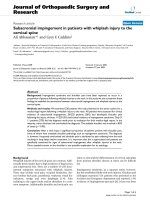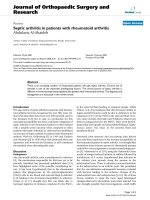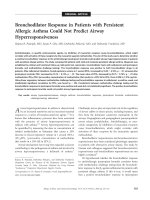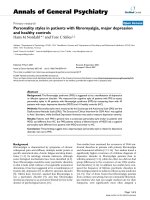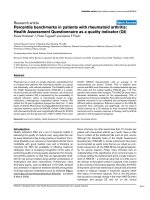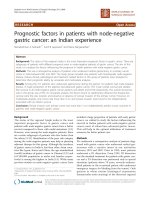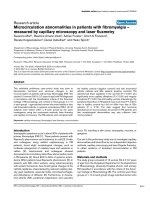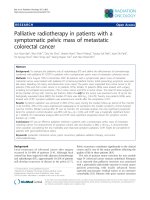Báo cáo y học: "Risk management in patients with severe acute pancreatitis" pdf
Bạn đang xem bản rút gọn của tài liệu. Xem và tải ngay bản đầy đủ của tài liệu tại đây (37.74 KB, 3 trang )
430
CT = computed tomography; FNAB = fine needle aspiration biopsy; SAP = severe acute pancreatitis.
Critical Care December 2004 Vol 8 No 6 Gerlach
Introduction
Severe acute pancreatitis (SAP) can progress to a critical
condition within a few hours or days after the onset of
symptoms. Particularly during the early course of the disease,
patients are at high risk for developing infections with
subsequent multiple organ dysfunction syndrome. Therefore,
early surgical intervention has been favoured, although
evidence-based data are lacking. In this issue of Critical
Care, De Waele and coworkers [1] present findings from a
critical review conducted over nearly a decade. In contrast to
many prior recommendations, the authors could not find any
significant association between the timing of surgery and
patient outcomes. Moreover, they identified patient age,
severity of organ dysfunction at the time of surgery, and the
presence of sterile necrosis as the main risk factors, and
concluded that an early surgical intervention is not justified in
the absence of proven infection when necrosis is detected
after computed tomography (CT) scan [1]. These important
findings once again raise the issue of risk assessment in the
individual patient with SAP.
Current practice
A major problem in the treatment of patients with SAP is the
lack of randomized trials. Recently, King and coworkers [2]
reported results from the first pan-European survey
conducted among specialists in hepato-pancreato-biliary
surgery of surgical strategies for management of SAP, with
the aim being to highlight areas of discordance and thus
provide a rational focus for future research. A questionnaire
survey of 866 surgeons was undertaken, and the response
rate was 38%. Severity stratification was used by 324
respondents (99%), with the Ranson score being the most
popular. Antibiotic prophylaxis was utilized by 73%, and fine
needle aspiration biopsy (FNAB) was undertaken by 53% of
respondents. Furthermore, the results show that there were
further aspects of practice that were concordant among
Commentary
Risk management in patients with severe acute pancreatitis
Herwig Gerlach
Professor and Director, Department of Anesthesiology, Critical Care Medicine, and Pain Management, Vivantes – Klinikum Neukoelln, Berlin, Germany
Corresponding author: Herwig Gerlach,
Published online: 8 November 2004 Critical Care 2004, 8:430-432 (DOI 10.1186/cc3007)
This article is online at />© 2004 BioMed Central Ltd
Related to Research by De Waele et al., see page 513
Abstract
Primary or secondary infection of necrotized areas by enteral bacteria is considered a primary cause of
mortality in patients with severe acute pancreatitis (SAP). Indeed, 20–30% of patients die during the
course of the disease from multiple organ dysfunction after infection. This is why strategies such as
antibiotic prophylaxis and early surgical intervention are appealing, but the controlled data that support
these measures are insufficient. On the other hand, environmental risk factors (e.g. smoking, alcohol)
and genetic predisposition have been identified; together, these led to SAP being considered a
‘multifactorial’ disease. However, this description does not help the intensivist to assess risk in the
individual patient. A number of prognostic factors in SAP have been identified, and different scoring
systems have been developed that include therapy-associated and patient-related factors.
Nevertheless, at present no prognostic model is available that takes into account all of these
predictors. Moreover, despite several attempts to create guideline-based strategies, SAP is still
characterized by rapidly progressive multiple organ failure and high mortality, and both surgical and
conservative therapies yield poor outcomes. This brief commentary highlights the most recent
developments in risk management for patients with SAP.
Keywords organ failure, pancreatic necrosis, predictors, risk assessment, severe acute pancreatitis
431
Available online />surgeons, such as use of early CT and agreement that
infected necrosis should be treated surgically. However,
there were unexpected findings that demonstrate that
enclaves of heterodox practice in the treatment of SAP
persist in Europe; for example, some surgeons advocated
nonoperative management of FNAB-proven infected
necrosis. Importantly, there was no consensus regarding the
optimal timing of surgery. Chiang and coworkers [3]
compared management of patients with SAP between two
centres in Australia. They found that all diagnostic tests for
severity stratification recommended by current practice
guidelines were performed in only 38% of patients.
Prognostic models
Early deaths in patients with SAP are rare, mainly as a result
of modern intensive care treatment. A retrospective analysis
[4] found that nine out of 10 deaths occurred more than
3 weeks after the onset of disease. This emphasizes the
importance of prognostic models, especially early in the
course of disease. Several risk factors for SAP have been
described. Patients with android fat distribution and higher
waist circumference are at greater risk for developing SAP
[5]. This finding was interpreted to be related either to the
amount of abdominal fat or to an overactive systemic
inflammatory response that tended to be upregulated in
those with android fat distribution. A meta-analysis of the
same group 2 years later [6] revealed that obesity (defined as
a body mass index of ≥ 30 kg/m
2
) carries a significant
2.6-fold higher risk for development of SAP, and up to a
4.6-fold higher risk for complications. Pupelis and coworkers
[7] found increased intra-abdominal pressure (≥ 25 cmH
2
O),
which is related to body weight, to be a risk factor for early
organ dysfunction, and therefore they recommended
monitoring of intra-abdominal pressure in patients with SAP.
Primary and secondary infections, however, are still
considered the determining factors for fatal outcome in
patients with SAP. In particular, Luiten and coworkers [8]
reported that Gram-negative intestinal colonization (except
that with Escherichia coli) carries a significantly increased
risk for pancreatic infection and mortality, and De Waele and
colleagues [9] found a trend toward increased risk for
development of renal failure among patients with fungal
infections, although no significant difference in patient
outcomes was described. Halonen and coworkers [10]
attempted to develop a multivariate model using new
strategies involving neuronal networks. Interestingly, their
optimal prediction model (logistic approach) identified four
variables: age, greatest serum creatinine value within
60–72 hours from primary admission, need for mechanical
ventilation, and chronic health status. In contrast, ‘classic’
scores (Ranson, Imrie) were inaccurate, with accuracy values
of 0.65 and 0.54, respectively. However, the model was
developed primarily to permit early prediction of hospital
mortality and not to classify the severity of SAP over time,
and so infection status was not included in the analysis.
Current trends in treatment for severe acute
pancreatitis
Although the studies cited above yielded contradictory
findings regarding the importance of infection status, current
recommendations are clearly aimed at preventive and
therapeutic measures to reduce the bacterial focus. Büchler
and coworkers [11] concluded that patients with infected
necrosis should be treated surgically, whereas conservative
management, including early antibiotic administration, is
promising in the case of sterile pancreatic necrosis. The
same group formulated an algorithm including antibiotic
administration as a standard in SAP [12], and repetitively
stated that ‘there is no doubt that pancreatic infection is the
major risk factor in necrotizing pancreatitis with regard to
morbidity and mortality’ [13]. Recently, the validity of that
statement was cast into doubt by the findings of a placebo-
controlled, double-blind trial [14], which surprisingly revealed
that antibiotic prophylaxis had no benefit with respect to risk
for developing infected necrosis or mortality. In conclusion,
antibiotic prophylaxis in SAP remains controversial. In
contrast, for treatment of infected necrosis, surgical
intervention with either laparotomy or ultrasound- or CT-
guided drainage is widely accepted, and the International
Association of Pancreatology recently reported guidelines
that include recommendations for surgical techniques [15].
Altogether, in contrast to therapy-associated risk factors, the
importance of patient-related variables in SAP remain
undetermined and merits further attention.
Conclusion
Data from different groups of investigators lead to the
following conclusion; assessment of individual risk and
optimal treatment in SAP remain areas of uncertainty. A major
reason for this uncertainty is misleading statistics, or at least
questionable interpretation of them, which often take only
single variables into consideration. However, several studies
using multivariate strategies [1,10] confirmed that there is
considerable coupling of variables, and that conclusions
should be drawn with caution. For example, if early surgical
intervention is associated with increased mortality, then this
does not necessarily mean that the surgeon employed the
wrong strategy. The severity of organ dysfunction at the time
of surgery clearly is a major risk factor. In other words, the
increased risk for death in these patients is not necessarily
treatment associated, but rather it could be patient related.
Hopefully, new imaging techniques [16] as well as novel
approaches with which to assess genetic predisposition [17]
may lead to improved risk management in patients with SAP.
Future studies should focus on the identification of individual
risk factors, which might permit application of specific,
evidence-based guidelines rather than general
recommendations.
Competing interests
The author(s) declare that they have no competing interests.
432
Critical Care December 2004 Vol 8 No 6 Gerlach
References
1. De Waele JJ, Hoste E, Blot SI, Hesse U, Pattyn P, de Hemptinne
B, Decruyenaere J, Vogelaers D, Colardyn F: Perioperative
factors determine outcome after surgery for severe acute
pancreatitis. Crit Care 2004, 8:R504-R511.
2. King NK, Siriwardena AK: European survey of surgical strate-
gies for the management of severe acute pancreatitis. Am J
Gastroenterol 2004, 99:719-728.
3. Chiang DT, Anozie A, Fleming WR, Kiroff GK: Comparative
study on acute pancreatitis management. ANZ J Surg 2004,
74:218-221.
4. Gloor B, Müller CA, Worni M, Martignoni ME, Uhl W, Büchler
MW: Late mortality in patients with acute pancreatitis. Br J
Surg 2001, 88:975-979.
5. Mery CM, Rubio V, Duarte-Rojo A, Suazo-Barahona J, Peláez-
Luna M, Milke P, Robles-Díaz G: Android fat distribution as pre-
dictor of severity in acute pancreatitis. Pancreatology 2002, 2:
543-549.
6. Martínez J, Sánchez-Payá J, Palazón JM, Suazo-Barahona J,
Robles-Díaz G, Pérez-Mateo M: Is obesity a risk factor in acute
pancreatitis? A meta-analysis. Pancreatology 2004, 4:42-48.
7. Pupelis G, Autrums E, Snippe K, Melbarde-Gorkusa I: Increased
intra-abdominal pressure: an important risk factor of early
organ dysfunction in severe acute pancreatitis. Zentralbl Chir
2002, 127:982-986.
8. Luiten EJ, Hop WC, Endtz HP, Bruining HA: Prognostic impor-
tance of gram-negative intestinal colonization preceding pan-
creatic infection in severe acute pancreatitis; results of a
controlled clinical trial of selective decontamination. Intensive
Care Med 1998, 24:438-445.
9. De Waele JJ, Vogelaers D, Blot S, Colardyn F: Fungal infections
in patients with severe acute pancreatitis and the use of pro-
phylactic therapy. Clin Infect Dis 2003, 37:208-213.
10. Halonen KI, Leppäniemi AK, Lundin JE, Puolakkainen PA, Kemp-
painen EA, Haapiainen RK: Predicting fatal outcome in the early
phase of severe acute pancreatitis by using novel prognostic
models. Pancreatology 2003, 3:309-315.
11. Büchler MW, Gloor B, Müller CA, Friess H, Seiler CA, Uhl W:
Acute necrotizing pancreatitis: treatment strategy according
to the status of infection. Ann Surg 2000, 232:619-626.
12. Gloor B, Schmidtmann AB, Worni M, Ahmed Z, Uhl W, Büchler
MW: Pancreatic sepsis: prevention and therapy. Best Pract
Res Clin Gastroenterol 2002, 16:379-390.
13. Werner J, Uhl W, Hartwig W, Hackert T, Müller C, Strobel O,
Büchler: Modern phase-specific management of acute pan-
creatitis. Dig Dis 2003, 21:38-45.
14. Isenmann R, Rünzi M, Kron M, Kahl S, Kraus D, Jung N, Maier L,
Malfertheimer P, Goebell H, Beger HG, and The German Antibi-
otics in Severe Acute Pancreatitis (ASAP) Study Group: Prophy-
lactic antibiotic treatment in patients with predicted severe
acute pancreatitis: a placebo-controlled, double-blind trial.
Gastroenterology 2004, 126:997-1004.
15. Uhl W, Warshaw A, Imrie C, Bassi C, McKay CJ, Lankisch PG,
Carter R, Di Magno E, Banks PA, Whitcomb DC, et al.: IAP
guidelines for the surgical management of acute pancreatitis.
Pancreatology 2002, 2:565-573.
16. Arvanitakis M, Delhaye M, De Maertelaere V, Bali M, Winant C,
Coppens E, Jeanmart J, Zalcmann M, Van Gansbeke D, Devière J,
et al.: Computed tomography and magnetic resonance
imaging in the assessment of acute pancreatitis. Gastroen-
terology 2004, 126:715-723.
17. Sahin-Toth M: The pathobiochemistry of hereditary pancreati-
tis: studies on recombinant human cationic trypsinogen. Pan-
creatology 2001, 1:461-465.

